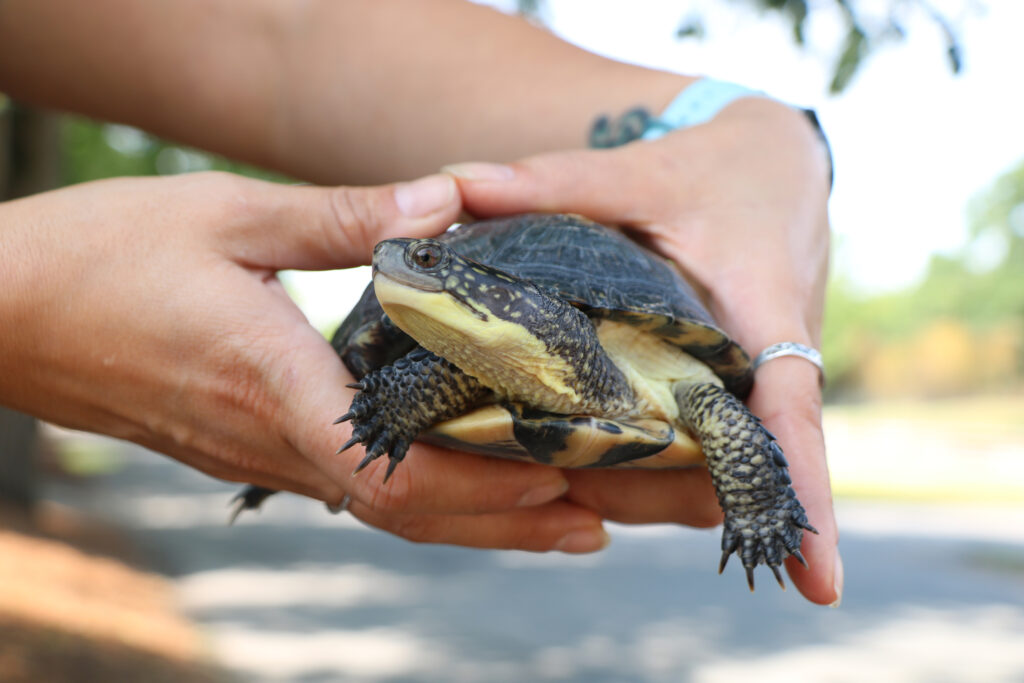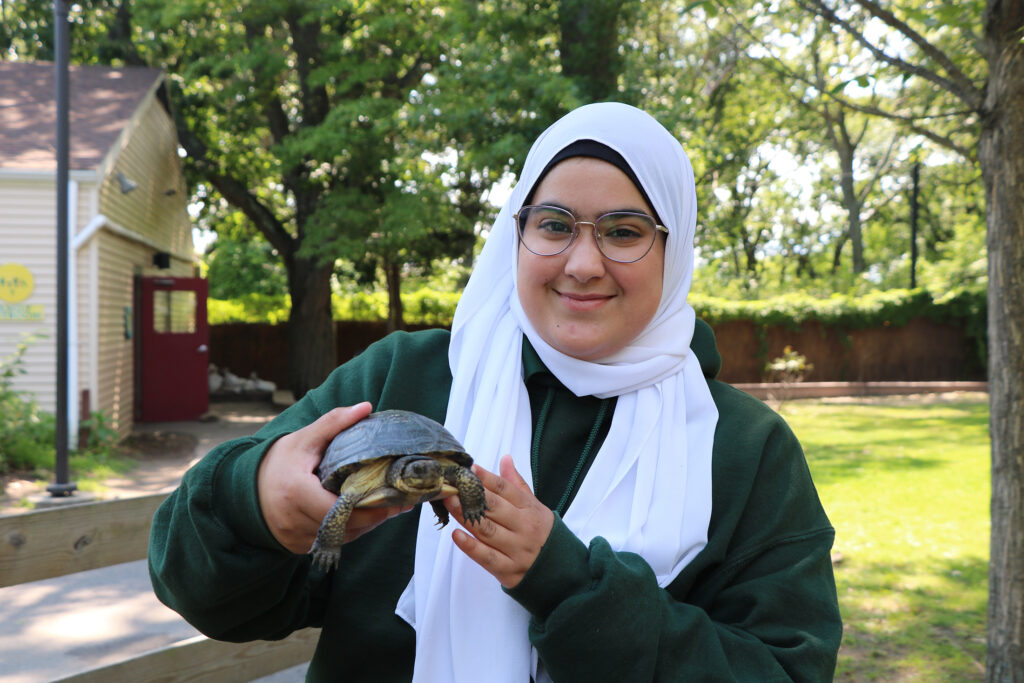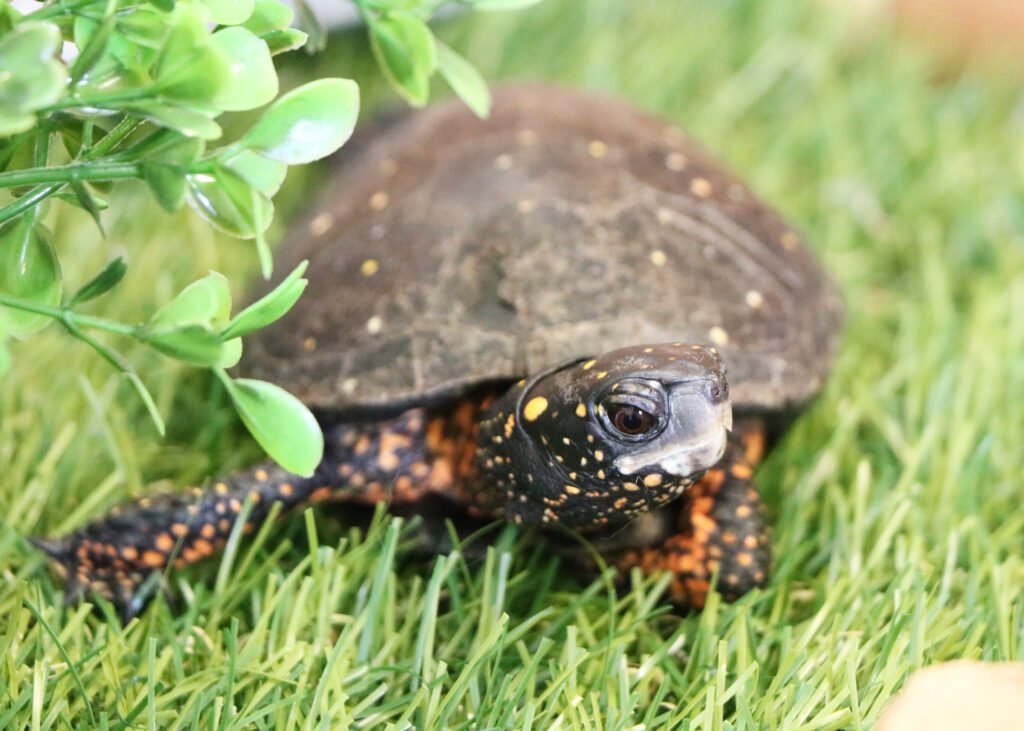Our Field Conservation team is deeply committed to studying and protecting turtle populations in local wetlands and woods. But we can’t do it alone. We don’t want to!
An important part of our turtle conservation work involves inspiring our community to join us in taking action to protect wildlife and wild places all around us. It takes a village, after all. We created the Conservation Society to give people a front-row seat to our field conservation efforts, and sometimes a chance to lend a hand in the field. The award-winning HATCH program has been introducing local turtles to many thousands of local grade school students since 2009.

We love sharing our passion for wildlife conservation with our guests at our zoos too. With more than a million people visiting Franklin Park Zoo and Stone Zoo each year, that’s a lot of people who can support this important work!
And that’s where our turtle ambassadors come in.
Animal Ambassadors
Like many of our larger residents, our ambassador Blandings and spotted turtles are part of Species Survival Plans (SSPs), which aim to preserve the species by maintaining healthy populations in human care. Here they have access to world-class veterinary care, nutritious and fresh diets prepared by hand and doting keepers who cater to their wellbeing every day. Some of you may know our turtle ambassadors already!
Phoenix and Donatella box turtles have been engaging guests at Stone Zoo’s Animal Discovery Center for years now. Floyd, a Blandings turtle, lives behind the scenes at Franklin Park Zoo, but he visits local schools or mingles with guests alongside one of our Franklin Park Zoo educators during warmer months. Interacting with our ambassadors, whether it’s one of our smaller animals greeting guests with educators or larger animals in their zoo habitat, helps guests make a connection with our animal neighbors who share our planet and hopefully inspire them to take action to protect these species.

Consider our turtles, for example. They give our educators an opportunity to talk about turtles as pets. While turtles certainly are endearing, pet turtles live for a long time — longer than some people are willing to commit to their care. Turtles kept as pets should never be released into the wild because they may carry diseases that could be catastrophic for the native wild turtle population. Local turtle species area also threatened by habitat segmentation, pollution, road mortalities, predation and illegal wildlife trade. Wild spotted turtles, for example, have unfortunately suffered as a result of the pet trade — another reason be caution about getting pet turtles. Spotted turtles (like most native turtles) are a protected species in Massachusetts and it is illegal to collect them.

Spotted Turtle Spotlight
Stone Zoo is actually home to a special spotted turtle ambassador name Rudy. Spotted turtles are small, aquatic reptiles native to the eastern United States with yellow spots on their shell and head. Those spots are thought to help them camouflage in ponds with duckweed, a small aquatic plant. Each turtle’s spot pattern is unique and can be used to identify individuals, like a human’s fingerprint or a zebra’s stripes.
While our Zoo New England biologists are currently radio tracking wild spotted turtles around Boston, our Zoo guests can observe spotted turtles like Rudy, who was born in human care and came to Zoo New England as a youngster. For a long time, he had a condition where he gradually lost the use of his back legs and could not stay buoyant in the water. The veterinary team could not identify a definitive cause. Out of an abundance of caution, the care team moved him into a habitat without deep water for fear that he could drown. Unfortunately, his mobility continued to decline.
That’s when his care team at Stone Zoo embarked on a physical therapy program to get Rudy back to swimming shape and improve his quality of life. Call it a Spotted Turtle Boot Camp. Over the course of last summer, Animal Care Specialist Danya and the education team at Stone Zoo supervised water therapy sessions with Rudy in a small outdoor pool, with added strength training through back scratches (see adorable video below!). Over many months, the care team slowly increased the depth of water in Rudy’s pool. Rudy’s legs got better and his ability to swim returned.
Now Rudy lives full-time in a large tank with plenty of room to swim and a land portion to rest and bask on with his companion Cathy. He’s a valued member of our animal ambassador team, helping to teach guests about the threats spotted turtles face in the wild and our conservation work in the field. In fact, Rudy is doing so well that he is a potential candidate to be in the breeding population for the AZA’s Spotted Turtle Survival Plan. The transformation of Rudy is a testament of the hard work and dedication Danya and the education team gave to Rudy to make sure he was living a fulfilled life.
The next time you visit the zoo, look out for Rudy or another of our animal ambassadors alongside an educator. No matter their size, all the animals at our zoos have important stories to tell about Zoo New England’s conservation efforts and exceptional animal care.
